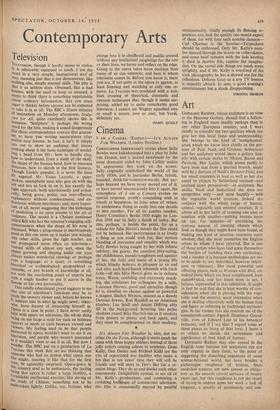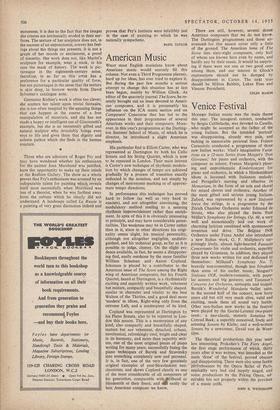Art
GERMAINE RICHTER, whose sculpture is on view at the Hanover Gallery, should find a follow- ing in England more readily perhaps than in any other European country, and I want chiefly to consider the two qualities which can give her this local fame and understanding. She belongs to the kind of 'metaphysical' artist which we know here chiefly in the per- sons of Paul Nash and Graham Sutherland and her sculpture would share a gallery hap- pily with certain works by. Moore, Bacon and Paolozzi. Her Spider, which seems partly to have been cast from a gnarled branch, might well be a denizen of Nash's Monster Field, and her small creatures in lead as well as her Ant could be objects by Sutherland realised—and realised more persuasively—in sculpture.' But unlike Nash and Sutherland she does not sympathise only — and most happily — with the vegetable world creation. Indeed she conjures with the whole range of human, animal, vegetable and mineral creation. It is above all in her habit of crossing one part of creation with another—putting breasts upon an ant, for instance—of abolishing the systema naturce, of creating objects which look as though they might have been found, of making one kind of creature comment upon another, that she most resembles the English artists to whom I have referred. She is one of those artists who have laid upon themselves the burden of building their own mythology, and a burden it is because mythologies are not to be made by any individual, however intelli- gent of visionary. Her most powerful and affecting pieces, such as Woman with Bird, are indeed those which arc least complicated, least metaphysical, and her finest work is not, I believe, represented in this exhibition. It might in fact be said that she is least worthy of con- sideration when she is playing with the vege- table and the mineral, most impressive when she is dealing objectively with the human face and figure or referring to traditional mytholo- gies. In the former role she reminds me of the ninenteenth-century French illustrator Grand- ville, even of Edward Lear in his botanical fantasies, and if I say that I regard some ef these pieces as being of that level, I leave it to others to decide the seriousness and significance of that kind of fantasy.
Germaine Richier may also appeal to the English taste because her sculptures are not only organic in their form, to the point of suggesting the disturbing organisms of some science-fictional world, but have besides a picturesque roughness of texture. Such modelled textures are now almost as obliga- tory as the smooth carved surfaces of twenty years ago, but this roughness is not the result of trying to impose upon her work a lack of elegance, a quality of spontaneity and sett-
suousness; it is due to the fact that the images she creates are intrinsically eroded in their sur- faces. The texture of her sculpture does not, in the manner of an expressionist, convey her feel- ings about the things she presents, it is not a graph of her moods or excitement, a proof of sincerity. Her work does not, like Marini's sculpture for example, wear a mask, in his case the mask of history. The work is pic- turesque in the eighteenth•century sense, therefore, in so far as this artist has a preference for a particular quality of form, but not picturesque in the sense that the texture is skin deep, to borrow words from David Sylvester's catalogue note.
Germaine Richier's work is often too clever; she scatters her talent upon trivial fantasies, she is too often tempted by the amusing things that can happen in the course of a free manipulation of materials, and she has not made a happy or intelligent use of Giacometti's example, but she is an immensely gifted and natural sculptor who invariably brings even toys to life and gives them that dignity and solemn pathos which she finds in the human creature.
Those who are admirers of Roger Fry and may have wondered whether his enthusiasm for the painter Jean Marchand was justified, have the opportunity to make up their minds at the Redfern Gallery. The show as a whole proves that Fry's enthusiasm was aroused by an indisputable talent for painting which reveals itself most successfully when Marchand was less of a theorist, when he was farthest away from the cubism which he clearly did not understand. A landscape called La Russie is a painting of very great distinction indeed and
proves that Fry's instincts were infallibly just in the case of painting to which he was naturally sympathetic.
BASIL TAYLOR











































 Previous page
Previous page